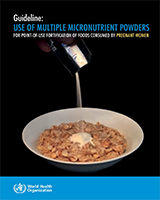ANNEX 8QUESTIONS IN POPULATION, INTERVENTION, CONTROL, OUTCOMES (PICO) FORMAT
Effects and safety of multiple micronutrient powders for pregnant women
Should multiple micronutrient powders be used in pregnant women to improve health outcomes?
If so, at what dose, frequency and duration?
View in own window
| POPULATION: | Pregnant women (any trimester and parity)
Subpopulations:
Critical
- –
By anaemia status: anaemia (defined as haemoglobin values <100 g/L) versus non-anaemia versus mixed/not reported - –
By iron status: iron deficient (as defined by ferritin, transferritin receptor, and/or zinc protoporphyrin cut-off values) versus non-iron deficient versus mixed/not reported - –
By malaria risk in the trial: malaria-free versus some risk (by use of concurrent antimalarial measures)
|
|---|
| INTERVENTION: | Point-of use fortification with micronutrient powders containing iron and folic acid
Subgroup analyses:
Critical
- –
By iron content of product: 30–59 mg versus ≥60 mg - –
By frequency: daily versus weekly versus flexible - –
By duration of intervention: - –
During pregnancy alone: less than 3 months versus 3 or more months - –
During pregnancy and the early postpartum period (0–3 months): less than 3 months versus 3 or more months
|
|---|
| CONTROL: |
- –
No provision of multiple micronutrient powders, or placebo - –
Iron and folic acid supplements
|
|---|
| OUTCOMES: | Maternal
Critical
- –
Haemoglobin values at term of pregnancy - –
Anaemia at term of pregnancy - –
Iron deficiency anaemia at term of pregnancy - –
All-cause morbidity - –
Morbidity from preeclampsia/hypertension - –
Morbidity from haemorrhage - –
Adverse effects: diarrhoea
For malaria-endemic areas only
- –
Malaria incidence and severity (parasitaemia with or without symptoms) - –
Placental malaria
Neonates and infants
Critical
- –
Gestational age <32 weeks versus 32–36 weeks versus ≥37 weeks) - –
Gestational weeks - –
Low birth weight (<1500 g versus 1500–2499 g versus ≥2500 g) - –
Birth weight (g) - –
Stillbirths - –
Iron status - –
Haemoglobin concentrations
|
|---|
| SETTING: |
- –
All settings
|
|---|

